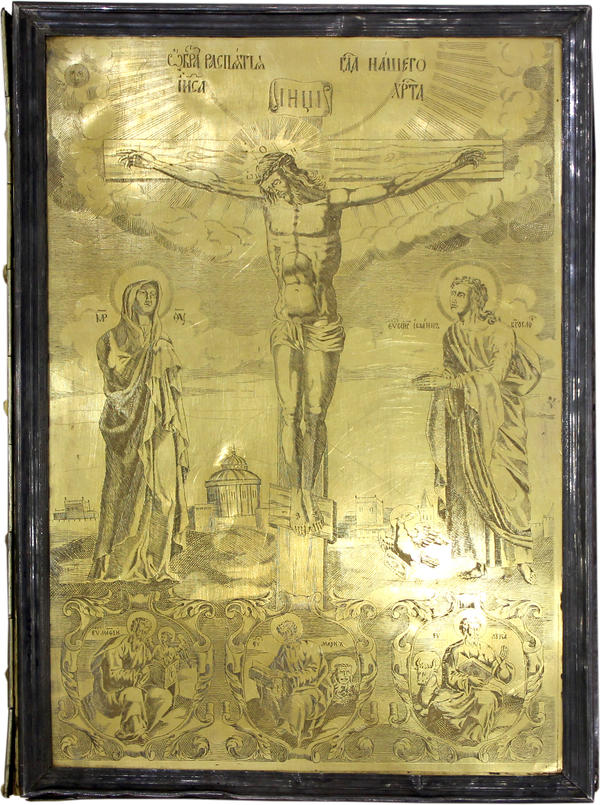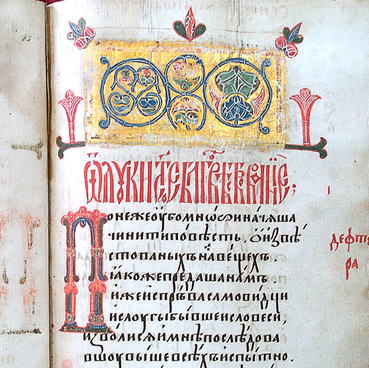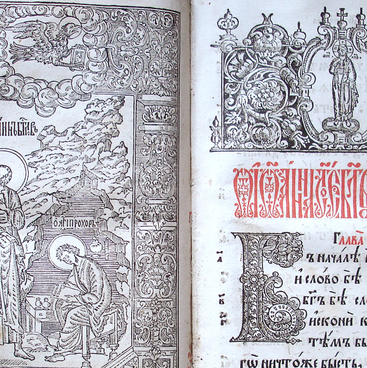The book came from the church of the village of Makarovka in 1939, and it was registered in the museum records on January 10, 1940.
Measured with its cover, the Gospel is 53 cm high, 38 cm wide, and 10.7 cm thick. The size of the sheets is 51×36 cm. The binding was made in the early 18th century, of two boards in a metal frame (gilded brass plates). The top cover is decorated with engravings depicting a crucifix and three Evangelists: Matthew, Mark and Luke. The back is adorned with floral patterns, and the book edge is gilt with relief work. The book used to have clasps, but they did have been lost.
The inside of the Gospel is no less expressive than its outside. When it was created, two-ink printing technology was used. The pages contain pagination and signature marks in Cyrillic numerals, as well as engravings with the Evangelists and a crucifix. The frames, the tailpieces and the initials include ornamental patterns. Headpieces show evangelical episodes: Annunciation; Epiphany; Our Lady, Christ, and John the Baptist; Resurrection.
Unfortunately, the book’s condition today leaves much to be desired. Its title page has been lost, many pages are damaged, and some sheets are heavily soiled with wax streaks. Both binding boards have cracks. The Gospel was kept in the village of Makarovka, near Saransk, in the patrimonial church of Deacon Makari Artemyevich Polyansky (1650-1710). The book was transferred to the museum in 1939, and was registered in the museum records in 1940.
Measured with its cover, the Gospel is 53 cm high, 38 cm wide, and 10.7 cm thick. The size of the sheets is 51×36 cm. The binding was made in the early 18th century, of two boards in a metal frame (gilded brass plates). The top cover is decorated with engravings depicting a crucifix and three Evangelists: Matthew, Mark and Luke. The back is adorned with floral patterns, and the book edge is gilt with relief work. The book used to have clasps, but they did have been lost.
The inside of the Gospel is no less expressive than its outside. When it was created, two-ink printing technology was used. The pages contain pagination and signature marks in Cyrillic numerals, as well as engravings with the Evangelists and a crucifix. The frames, the tailpieces and the initials include ornamental patterns. Headpieces show evangelical episodes: Annunciation; Epiphany; Our Lady, Christ, and John the Baptist; Resurrection.
Unfortunately, the book’s condition today leaves much to be desired. Its title page has been lost, many pages are damaged, and some sheets are heavily soiled with wax streaks. Both binding boards have cracks. The Gospel was kept in the village of Makarovka, near Saransk, in the patrimonial church of Deacon Makari Artemyevich Polyansky (1650-1710). The book was transferred to the museum in 1939, and was registered in the museum records in 1940.
The book is extant with some minor losses – the title page is absent, some pages are damaged and soiled with wax drops. The Gospel was kept in the village of Makarovka, near Saransk, in the patrimonial church of Deacon Makari Artemyevich Polyansky (1650-1710).
The St. John the Theologian Church in the village of Makarovka is an example of a religious building in the style of so-called “Naryshkin Baroque.” Luxurious multilevel centrally-planned churches, characteristic of the Russian architecture of the 17th and 18th centuries, became a symbol of importance of large landowners of the nobility of the time. Government official Makary Artemyevich Polyansky was one of them.
Striking in its monumentality, the church situated in the Makarovka churchyard was decorated with architectural elements designed to emphasize the landowner’s wealth and influence. At the time, this church had no equals in beauty and grandeur among religious buildings of the Saransk District. Makary Polyansky is believed to have a strong penchant for the architecture of the Stroganov School. As the designer of the St. John the Theologian Church, he put himself on a par with large industrialist Stroganov who had financed the construction of a huge cathedral in Solvychegodsk in 1693.
In Russian history, Makary Polyansky is known as a prominent representative of the community of government officials of the second half of the 17th century. He devoted his whole life to serving his Motherland and the Tsar, starting with the position of a petty clerk in the mid-1660s. In 1677 and 1678, Polyansky took part in the Chigirin campaigns, and in 1679, he defended Kiev under command of Prince Mikhail Dolgorukov. By an imperial decree dated September 26, 1680, Polyansky was given permission to choose land for his estate in the Saransk or Penza District.
During the Streltsy Uprising of 1682, the young nobleman proved his loyalty to the Tsar once again. As a government official, he participated in peace negotiations with the Polish-Lithuanian Commonwealth in 1686, and was overseeing erection of a fortress in the lands of the Zaporozhye Cossacks in 1688. The construction took six months, from March to August. In April, a church was founded in the town of Samar, and consecrated in honor of the Intercession of Holy Virgin on August 1. Therefore, the fortress was called Novobogoroditskaya (New Fortress of Holy Virgin).
In the autumn of 1688, Polyansky was promoted from clerk to deacon for merits to the Fatherland and was granted an additional salary in the form of land and money. By 1700, he had estates and homesteads not only in the Saransk Districts, but also in the Mozhaisk, Vladimir, Zvenigorod, Vologda, Yaroslavl, Nizhny Novgorod and Murom Districts. For the construction of the Novobogoroditskaya fortress, he was presented with a silver ladle with gold plating by Tsars John and Peter, sons of Alexei. This masterpiece of jewelry art is now kept at the Armory Chamber of the Moscow Kremlin.
Makary Polyansky worked in public service until his death. He died in Novgorod in 1710. He was buried in his Saransk estate, in the vault of the St. John the Theologian Church in Makarovka. The beautiful church that he had once built became his monument. In 1923, Makar Polyansky’s crypt was destroyed by the Bolsheviks.
The St. John the Theologian Church in the village of Makarovka is an example of a religious building in the style of so-called “Naryshkin Baroque.” Luxurious multilevel centrally-planned churches, characteristic of the Russian architecture of the 17th and 18th centuries, became a symbol of importance of large landowners of the nobility of the time. Government official Makary Artemyevich Polyansky was one of them.
Striking in its monumentality, the church situated in the Makarovka churchyard was decorated with architectural elements designed to emphasize the landowner’s wealth and influence. At the time, this church had no equals in beauty and grandeur among religious buildings of the Saransk District. Makary Polyansky is believed to have a strong penchant for the architecture of the Stroganov School. As the designer of the St. John the Theologian Church, he put himself on a par with large industrialist Stroganov who had financed the construction of a huge cathedral in Solvychegodsk in 1693.
In Russian history, Makary Polyansky is known as a prominent representative of the community of government officials of the second half of the 17th century. He devoted his whole life to serving his Motherland and the Tsar, starting with the position of a petty clerk in the mid-1660s. In 1677 and 1678, Polyansky took part in the Chigirin campaigns, and in 1679, he defended Kiev under command of Prince Mikhail Dolgorukov. By an imperial decree dated September 26, 1680, Polyansky was given permission to choose land for his estate in the Saransk or Penza District.
During the Streltsy Uprising of 1682, the young nobleman proved his loyalty to the Tsar once again. As a government official, he participated in peace negotiations with the Polish-Lithuanian Commonwealth in 1686, and was overseeing erection of a fortress in the lands of the Zaporozhye Cossacks in 1688. The construction took six months, from March to August. In April, a church was founded in the town of Samar, and consecrated in honor of the Intercession of Holy Virgin on August 1. Therefore, the fortress was called Novobogoroditskaya (New Fortress of Holy Virgin).
In the autumn of 1688, Polyansky was promoted from clerk to deacon for merits to the Fatherland and was granted an additional salary in the form of land and money. By 1700, he had estates and homesteads not only in the Saransk Districts, but also in the Mozhaisk, Vladimir, Zvenigorod, Vologda, Yaroslavl, Nizhny Novgorod and Murom Districts. For the construction of the Novobogoroditskaya fortress, he was presented with a silver ladle with gold plating by Tsars John and Peter, sons of Alexei. This masterpiece of jewelry art is now kept at the Armory Chamber of the Moscow Kremlin.
Makary Polyansky worked in public service until his death. He died in Novgorod in 1710. He was buried in his Saransk estate, in the vault of the St. John the Theologian Church in Makarovka. The beautiful church that he had once built became his monument. In 1923, Makar Polyansky’s crypt was destroyed by the Bolsheviks.



